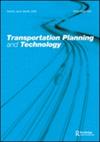新兴市场年轻人对电动汽车的采用:来自阿根廷的案例研究
IF 1.8
4区 工程技术
Q3 TRANSPORTATION SCIENCE & TECHNOLOGY
引用次数: 0
摘要
电动汽车(EV)市场的命运将取决于潜在买家的行为,以及新兴市场如何允许电动汽车被视为内燃机(IC)汽车产生的外部性的移动解决方案。为此,重要的是要确定心理因素所起的作用,以及工具属性,特别是在尚未成熟市场的年轻人(未来的购买者)中。我们的论文分析并建立了购买电动汽车的倾向与同等IC汽车的模型。它有助于研究新兴市场中年轻人行为的现有文献,重点关注态度和观念的作用。阿根廷科尔多瓦大学(University of Cordoba)设计并发布了一项基于真实商业场景(雷诺ZOE vs雷诺Clio)的陈述偏好调查。受访者的行为是在随机效用范式内建模的。首先,通过混合多项逻辑公式考察用户间的异质性;通过建立具有潜在变量的混合选择模型,探讨了心理态度因素的作用。估计结果表明,态度和观念在新兴市场中起着重要作用。关键词:混合动力离散选择模型潜在变量态度感知电动汽车新兴市场致谢本研究由MOST可持续移动国家研究中心开展,并获得欧盟下一代欧盟(PIANO NAZIONALE DI RIPRESA E RESILIENZA (PNRR) - mission one 4 COMPONENTE 2, INVESTIMENTO 1.4 - d.d 103317/06/2022, CN00000023)的资助。本手稿仅反映作者的观点和意见,欧盟和欧盟委员会都不能对他们负责。这项研究也得到了萨勒诺大学的部分支持,在当地的拨款编号。Orsa171328 - 2019。披露声明作者未报告潜在的利益冲突。注1传统汽车的每月成本是根据该车八年内的价格及每日约40公里市区行程的燃油成本计算。因此,估计每月的成本为€200.2重要的是要记住,我们正在处理的是在尚未建立基础设施的市场中选择购买电动汽车的学生最小样本量根据文献(Louviere, Hensher, and Swait Citation2000;Hensher, Shore, and Train Citation2005),使用以下解析表达式:n≥qpa2[φ−1(1+α2)]2,其中p为真实比例,q = 1 - p;α为置信水平(0.95);A为准确率(10%);为逆累积正态分布函数Cronbach 's alpha是一种保守的可靠性度量。而复合信度则倾向于高估内部一致性信度。因此,根据Hair et al. (Citation2017),真正的信度通常介于Cronbach’s alpha(代表下界)和复合信度(代表上界)之间只有对每个构念的信度和效度有贡献的陈述才会被报告与其他属性不同,每月成本属性是唯一连续的属性直接弹性确定为:E=Δpp⋅xΔxwhere Δp是由于成本变化而选择“购买”备选方案的概率变化,p是选择“购买”备选方案的概率变化,x是电动汽车和电动汽车之间的a Δ_Cost,假设为零,Δx是10到100%之间的成本变化。本文章由计算机程序翻译,如有差异,请以英文原文为准。
Adoption of electric vehicles by young adults in an emerging market: a case study from Argentina
ABSTRACTThe destiny of the electric vehicle (EV) marketplace will depend upon the behaviour of potential buyers and on how emerging markets allow EVs to be perceived as a mobility solution to the externalities generated by internal combustion (IC) vehicles. To this end it is important to ascertain the role played by psychological factors, along with instrumental attributes, especially among younger adults (future purchasers) in not yet mature markets. Our paper analyses and models the propensity to purchase an EV with respect to an equivalent IC vehicle. It contributes to the existing literature investigating younger adults’ behaviour in an emerging market, focusing on the role of attitudes and perceptions. A stated preferences survey, built on real commercial scenarios (Renault ZOE vs Renault Clio), was designed and disseminated at the University of Cordoba (Argentina). Respondent behaviour was modelled within the random utility paradigm. First, heterogeneity among users was investigated through mixed multinomial logit formulation; The role of psycho-attitudinal factors was then explored through the specification of hybrid choice models with latent variables. Estimation results indicate the significant role of attitudes and perceptions in emerging markets.KEYWORDS: Hybrid Discrete Choice Modellinglatent variablesattitudesperceptionselectric vehiclesemerging markets AcknowledgementsThis study was carried out within the MOST – Sustainable Mobility National Research Center and received funding from the European Union Next-GenerationEU (PIANO NAZIONALE DI RIPRESA E RESILIENZA (PNRR) – MISSIONE 4 COMPONENTE 2, INVESTIMENTO 1.4 – D.D. 1033 17/06/2022, CN00000023). This manuscript reflects only the authors’ views and opinions, neither the European Union nor the European Commission can be considered responsible for them. This research was also partially supported by the University of Salerno, under local grants no. ORSA171328 – 2019.Disclosure statementNo potential conflict of interest was reported by the author(s).Notes1 The monthly cost of the conventional car is calculated considering the price of the car in eight years and the fuel cost to undertake urban trips for a daily travelled distance of around 40 km. Therefore, the estimated monthly cost is €200.2 It is important to recall that we are dealing with students who are undertaking the choice of purchasing an electric vehicle in a not yet infrastructured market.3 The minimum sample size was preliminarily defined in accordance with the literature (Louviere, Hensher, and Swait Citation2000; Hensher, Shore, and Train Citation2005) by using following analytical expression: n≥qpa2[ϕ−1(1+α2)]2where p is the true proportion, q = 1 – p; α is the level of confidence (0.95); a is the accuracy (10%); and is the inverse cumulative normal distribution function.4 Cronbach’s alpha is a conservative measure of reliability. In contrast, composite reliability tends to overestimate the internal consistency reliability. Therefore, according to Hair et al. (Citation2017), true reliability usually lies between Cronbach’s alpha (representing the lower bound) and composite reliability (representing the upper bound).5 Only those statements contributing to the reliability and validity of each construct are reported.6 The monthly cost attribute was the only continuous attribute, unlike the others.7 The direct elasticity is determined as: E=Δpp⋅xΔxwhere Δp is the change in the probability of choosing the "buy" alternative, due to cost variation, p is the choice probability of the alternative ‘buy', x is a the Δ_Cost between EVs and ICVs, assumed to be zero, and Δx is the delta cost variation between 10 and 100%.
求助全文
通过发布文献求助,成功后即可免费获取论文全文。
去求助
来源期刊

Transportation Planning and Technology
工程技术-运输科技
CiteScore
3.40
自引率
6.20%
发文量
24
审稿时长
12 months
期刊介绍:
Transportation Planning and Technology places considerable emphasis on the interface between transportation planning and technology, economics, land use planning and policy.
The Editor welcomes submissions covering, but not limited to, topics such as:
• transport demand
• land use forecasting
• economic evaluation and its relationship to policy in both developed and developing countries
• conventional and possibly unconventional future systems technology
• urban and interurban transport terminals and interchanges
• environmental aspects associated with transport (particularly those relating to climate change resilience and adaptation).
The journal also welcomes technical papers of a more narrow focus as well as in-depth state-of-the-art papers. State-of-the-art papers should address transport topics that have a strong empirical base and contain explanatory research results that fit well with the core aims and scope of the journal.
 求助内容:
求助内容: 应助结果提醒方式:
应助结果提醒方式:


